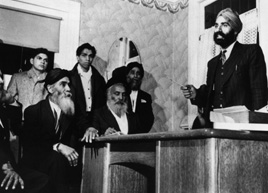





|

|
The Sikhs I interviewed began to feel that they were truly Canadians when they were granted full franchise rights, after more
than forty years in this country. Some of them had been born here, or had come as children and knew no other country, but it
was not until 1947 that their efforts for justice and fairness were rewarded with Canadian citizenship. Now all that remained
was for other Canadian people to recognize the Sikhs as their equals.
Canadians immigration laws were still unfair to East Indians: even though the Sikhs were now Canadian citizens, the laws
regarding immigration from India were not the same rules that applied to immigrants from Europe. East Indians were only
allowed to sponsor their wives and children under twenty-one years of age. If they wished to bring in their parents, brothers,
sisters, in-laws or other relatives, they had to apply through a quota system. The maximum was 150 persons per year, but in
reality the law allowed for only 50 persons per year for East Indians domiciled in Canada. Canadians from Europe were
allowed to bring in their relatives without any quota restrictions.
Another discriminatory rule was that an immigrant from India had to wait five years before getting Canadian citizenship and
applying for immigration for a spouse and minor children, while Europeans could apply immediately after becoming landed
immigrants.
The Khalsa Diwan Society elected a special thirteen-person committee, the Khalsa Diwan Welfare Committee, to lead the fight

|
Naginder Singh Gill, secretary of the Khalsa Diwan Society, conducts a meeting in the
office with the Vancouver Sikh Temple on the West 2nd Ave., 1946.
Seated left to right:
Gurdit Singh, Naranjan Singh, Mohan SIngh,.
Standing left to right: Jagat SIngh Uppal, Sadhu
Singh Uppal, Arjan Singh
|
for immigration right. This committee handled all correspondence between the Sikh community and the federal government. The
group later became the East Indian Canadian Citizens Welfare Association, which appealed not only to Ottawa but to the
government of India to change the unfair policies against immigrants from India. Finally in 1957, the quota for India was
increased to 300 people per year. The quota system was completely dropped in 1962, when new non-discriminatory
immigration regulations came into effect. The victory was complete when in 1967 the Liberal government introduced new
immigration regulations for Canada.
The older Sikhs I talked to have lived through decades of institutionalized discrimination, and they supported the community’s
long fight for the franchise and fairer immigration laws. But they were uncomfortable discussing racism and discrimination. They
preferred not to talk about these things because they felt there was nothing to be gained by bringing up the unpleasant aspects
of the past. The unfairness and injustice had not been directed just at them: " Look what happened to the poor Japanese, who
lost everything, " many of them pointed out. And they mentioned the Europeans known as DPs (displaced persons), who had
been left with no home and no country by war and political upheaval. These people were treated poorly by Canadians as well,
and they were white people. " We all knew where we stood, we knew our place. " Mr. Lachman Thandi sums it up, " We felt
inferior to the white people and that was more or less accepted. "
" We did not really go places where we were not accepted or challenge anyone needlessly. If one of us faced an injustice or
discrimination at the immigration office or the police station or some other place, we’d all say, " That’s all right Singh, forget
about it. "
|
cont...
[p.1]









|







